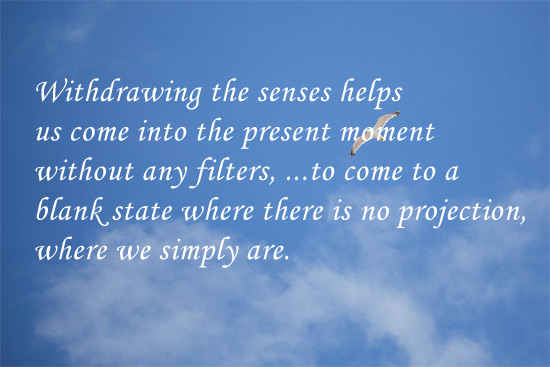
How and Why to Practice Pratyahara
In this article I would like to share with you one practical exercise that I have been using for decades, day-in-day-out. It is an invaluable part of my ego-transcending spiritual practice (or Sadhana for all of you familiar with the yoga terminology) and I can't imagine my life without it.
This spiritual exercise is called Pratyahara.
Despite the strange name, Pratyahara is a simple practice. I will describe it in just a minute, but first I would like to share with you several remarks.
Here, I don't want to go too much into the terminology. The reason is I want to share with you something extremely easy to learn and truly valuable, so there is no need to make things more complicated than they are.
Because of the simplicity of Pratyahara, you may be tempted to dismiss its importance and/or its long term beneficial effects.
Don't.

I am sharing this technique here for free, so you may be tempted to quickly go over it and forget it. Please don't.
For your own sake.
Pratyahara is something that I learned from my spiritual teacher, as I was just beginning my spiritual journey. Ever since that time, I've never stopped using it.
It is arguably one of the most useful practices I've ever encountered. I can't overemphasize the importance of this spiritual tool, either in my personal spiritual development, or in my life in general. That said, let's see ...
What Pratyahara actually is
The definition says Pratyahara is a process of consciously withdrawing of our senses.
In addition, if you are a yoga student, it might be useful to know that Pratyahara is one of the limbs in the Patanjali's "8 limbs of yoga path to liberation".
In fact, pratyahara is the fifth step in the Patanjali's yoga. The first four steps are more physical, like asanas and pranayamas, whereas the last three more spiritual, like meditation. So, pratyaraha is at the borderline between the physical and the metaphysical. That's probably what makes this step hard to understand for some yoga students. Here, I will try to clarify the confusion.
What does withdrawing of the senses mean?
We use our senses (sight, hearing, taste, smell, and touch) to perceive the world around us. When we do pratyahara, our aim is to consciously take a break from using our senses and detach ourselves from this process for a couple of minutes.
What do we actually withdraw our senses from?
The simple answer is from the external objects and external stimuli. For example, if we close our eyes we may start to withdraw our sight from the table in front of us, from the computer, TV set, and the entire array of objects around us.
But, in a broader sense, this withdrawal should include also the internal objects of the mind. These are all the objects that exist or have reflection in our inner, mental world and we sort of "see" them with our inner or "mental eye".
So the mental images and objects are also something we want to withdraw our senses from.
Why do we withdraw our senses?
Because our true self, God in us, cannot be touched, heard, seen, smelled, or tasted. It cannot be perceived via the sense. You can only BE your True self.
Our five senses are useful in the outer world to experience outer objects. They are also useful to experience objects of the mind. But to know your True self you have to go beyond the senses, and that's why Pratyahara is so useful.
Our senses are like hooks we use to cling to the illusion of the world. When you are in a safe environment, there's no need to hold on to your senses so strongly. Let them rest for a while. You will lose nothing, and you have enormously big things to get.

What happens when the senses are no longer engaged with outer objects?
When we withdraw our senses from the outer world, we can start to observe more clearly our thoughts and the mental objects or images connected with our thoughts.
The key point here is observing. Being a neutral observer of the thoughts. The train of thoughts won't stop at once. Therefore we need to observe it, without clinging to it, without engagement, without suppression.
When we stop the engagement of our senses with the object from the outer world, the next step is to stop the engagement of our senses with the thought patterns. Just letting the thoughts flow while our senses are not involved into them.
In time this train of thoughts will lose power and stop. But only if we withdraw our senses from it.
The habit of clinging
All this is easier said than done. Because we are so used to cling to our senses. This is like an addiction. We are strongly attached to this process of constantly perceiving the outer world as well as the inner world of thoughts, images, concepts, and mental objects. It is not enough to close your eyes and sit in a quiet place. It is not easy to break this habit because what we have to do is suspend our use of the inner faculty of sensing. This is really hard and it takes years of practice.

How to perform pratyahara?
There are several ways. Here I will describe the way that I use. It is quite simple really.
- I try to reduce the physical stimuli as much as I can. This is crucial, especially at the beginning. If your TV is turned on in the room where you try to do pratyahara, it's very likely you won't do anything with your practice.
Don't go overboard though. You don't have to pull the blinds down during the day, or such things. - Sit comfortably in a chair, on the floor, or try to get into any other comfortable position of your choice. Probably it is not a good idea to lie down, because if you do, you might fall asleep.
Remember, the idea is to remain conscious, not to doze off. Pratyahara is not relaxation, it is an exercise of awareness. However, the end result could be a total relaxation. Pratyahara can bring more relaxation than anything else you've tried in your life. - Close your eyes and try to move your body as little as possible for about 10 minutes.
That's it.
That's how I do it. As you can see, it is as simple as it gets. Just be there for 10 minutes without interfering with anything. But... usually there is a discrepancy between theory and practice...
...easier said than done.
From time to time, my spiritual teacher likes to say that the dumbest person in the world would do this exercise perfectly. Because they would not engage their senses into any activity, simply by virtue of being indifferent to anything that's happening around them.
Perfect for withdrawal of the senses.
Another technique
There are other, slightly different instructions you may follow when practicing pratyahara. For example, in step 3 above, you may choose to concentrate on one of your sense, for example on the hearing. Because your mind normally uses all five senses, and now is limited to only one, after a while it will get tired of the external sounds and it will turn inward. Some sources suggest focusing on the most distant sounds first , and slowly shifting your awareness to the nearby sounds until you have entirely withdrawn from the sense of hearing.
The bottom line
If you are a determined seeker of the Truth, Pratyahara is a necessary step on your spiritual path. You can learn so much about how you use your senses to perceive the world around you. You can also learn how to overcome the attachments to the outer and inner objects and become truly free of them.
If you only practice meditation occasionally, it is also worth learning pratyahara. It is really an easy to perform, effortless practice. It will help you detach yourself from the external world and enter more deeply into your inner world.
Pratyahara is an invaluable spiritual tool that brings great long term positive effects and can speed up you entire spiritual practice. Namaste!



















